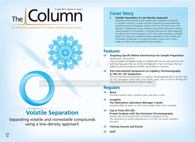The Alternative Laboratory Manager’s Guide
Incognito offers his advice on how to be a leader rather than a manager.
Photo Credit: Sunny studio/Shutterstock.com

Incognito offers his advice on how to be a leader rather than a manager.
There are many training courses, on-line guides, and self-help books on laboratory management. Most focus heavily on processes, quality, and regulatory aspects, which is fine because these are the nuts and bolts of the transactional activities that laboratory managers need to be involved with. However, there is so much more to the role than this and over many years I’ve observed the good, the bad, and the ugly aspects of what makes a good laboratory manager. Here I present a brief analysis of what I think makes a good manager focusing not on what you can learn on a training course, but on the critical aspects that rarely get mentioned in the training events and the selfâhelp books.
First, change your title and your mindset and become the “laboratory leader” rather than the laboratory manager. In general, people are motivated and inspired by leaders, they are managed by managers. If you aren’t aware of the difference between leadership and management, you may want to read on, or perhaps seeks out some training to help highlight the differences between the two.
Have a leadership style. There are many to choose from, but people respond best to leaders who can be “second guessed”. That is to say, they know the standards expected and know how you will react under various circumstances and adjust their behaviour to meet expectations.
Create a culture of entrepreneurial compliance. Obviously quality and compliance are at the top of the priorities list, but don’t discourage free thinking or chastise when staff point out their grumbles-positively encourage suggestions for change.
Take a leaf out of Google’s book-allow staff blue sky thinking time, but always insist that the outputs are shared, even if this is on a “virtual stick-it board”. Expect some staff members to take this more seriously than others, but don’t be discouraged. Make time to discuss suggestions and outputs with your team.
You will have seen the phrase: “Focus on people-truly your greatest asset” many times. It’s very easy to say, but in the busy, pressurized world of the modern laboratory, very difficult to deliver. The best leaders do put their people first, but you need to be very disciplined to resist your natural bent for logic and fact (I’m assuming you’re a scientist) and concentrate on the “softâskill” side of leadership in the face of the regulatory, quality, and processâdriven environment in which you work.
The Dali Lama said: “Share your knowledge, it’s a way to achieve immortality”. He couldn’t have been more right. The only way to be successful is to aim to make your staff more competent than you are. If “training and development” is a tick box on the staff review form which only gets addressed once a year, then you aren’t on the right track. If your entire professional development programme is delivered by internal staff or there simply “isn’t any training budget” then you need to have a serious conversation with your own manager, because you cannot create a great laboratory under these circumstances.
Develop your people by investing your own time and energy in them. A great exemplar of this attitude is to not answer all their troubleshooting issues. Let them work out things for themselves but mentor their decision-making processes and empower them to learn about the instrumentation and separation chemistry under investigation, allowing them to better understand the problem, the solution, and their work.
Don’t expect your people to perform without ensuring they are competent. That doesn’t mean testing their ability, it means imparting the necessary knowledge and skills for them to perform at the expected level. I’ve seen so many instances of laboratories with a ton of great equipment being horribly underutilized because less experienced staff have been left to operate instruments that frankly they are not fully competent to use.
“Build in quality”: a tired phrase which needs a huge amount of effort and good leadership to truly achieve. Don’t confuse this aspiration with the processes of quality monitoring. Expect the best from your people and develop this approach as a cultural ethos. Resist pressure to get results out of the door if it means properly assessing data, and defend your people if it means buying time for them to produce the best data they can. Become personally involved whenever an investigation is required into root cause analysis or out of specification data, and deal swiftly and decisively with examples of behaviour or decision-making that fall below your standards. Realize that audits are assessing the philosophy of your laboratory as well as the transactional and process-driven aspects.
Literature-both journals and trade literature-should be a big part of the working environment for your people to retain an outward perspective. Be outward looking and allow yourself and your people to attend conferences and seize opportunities to network. Always insist that a report of the event is generated so that others can share the insights gained.
Don’t have a two-tiered workforce. Folks employed entirely for the more menial tasks (sample prep for example) as a separate workforce to the “analysts” rarely creates a harmonious working atmosphere unless there is a very clear route for progression. Even then this rarely achieves the desired outcome of making the workflow more efficient and almost always fosters resentment.
Ensure that people see progression within the laboratory and a route for them to be rewarded when they exceed performance targets. Don’t close off senior technical roles-not everyone is management material and they may be much more useful to the business in a senior technical role.
Recruit the best people that you can-a vacancy is a luxury, unless you just lost your best person! It’s so tempting to recruit to fill up the spaces and feel the pressure to get “bodies” into the laboratory and produce data, even though the cohort you interview may not have produced any outstanding candidates. I’d say resist this wherever possible and go for the best every time-even if this means re-starting the search and delays to filling the vacancy.
Take great care in selecting instruments and pay as much attention to the data system as you do the instrument itself. Having a harmonized data collection and analysis system (not necessarily that used by the instrument manufacturer) can seem like a great idea, but do make sure that the software vendor has the proper control codes for all the key instruments because important features of the instruments can often become inaccessible from a lack of these codes.
When you buy a new instrument keep it under wraps to the wider business until your staff have had time to figure out what they don’t know about the instrument and what they know it’s capable of but can’t figure out how to attain. It’s so tempting to get this expensive asset generating data from the moment it crosses the threshold, but you must resist and provide the time and training necessary for your people to get the best out of the instrument. In my experience, there are no such things as “advanced features that we don’t need at the moment”.
Evaluate your laboratory performance, but consider using the findings as a carrot rather than a stick. Don’t metric the science and inspiration out of your laboratory. Recognize that metrics should be linked to training requirements.
Be aware of your department’s reputation and serve your customers well. This is perhaps one of the more esoteric aspects of the role, however, I see the best laboratory managers taking official and unofficial soundings to assess what their laboratory can do better, identify problems before they escalate, and identify new and extended services to offer the business. Have a solid complaint or failure investigation process and ensure that the process is stuck to during all investigations, but most important of all, ensure that your people know very clearly the standards and behaviours that you expect of them.
Communication is absolutely vital to a successful laboratory manager. We all know that communication between your laboratory and your clients is essential, however, the most crucial communication is with the folks who work in your laboratory, and you should aim to share good news and bad news as effectively as possible. Younger managers often feel awkward about addressing underperformance, poor practice, or disruptiveness. It’s this simple: if you don’t address these issues effectively you won’t build a successful team. Sharing good news is much easier, so seize the opportunity to broadcast exceptional performance or good feedback as widely as possible.
Invest in a time machine for yourself. It’s far too easy to get sucked into the vacuum of a “data equals performance” paradigm. When you’re under pressure to deliver take a step back and make time to analyze rate limiting steps, staff, and equipment capabilities. What’s driving this time pressure? How can you install a pressure relief valve that will help the whole workforce on an on-going basis?
These are just some of the considerations for successful laboratory leadership, and I know that many readers will be asking how on earth they are supposed to fit in these activities given the time and budgetary constraints under which they are working. Well, that’s the challenge you took on, and these more esoteric aspects are what separates the great from the transient.
Take care of your people, pride in your standards, and fight for the development of your staff and the capabilities of your laboratory. Don’t just manage, lead.
Contact author: Incognito
E-mail: admin@chromatographyonline.com

A Final Word from Incognito—The Past, Present, and Future of Chromatography
February 10th 2022After 14 years in print, Incognito’s last article takes a look at what has changed over a career in chromatography, but it predominantly focuses on what the future might hold in terms of theory, technology, and working practices.
Sweating the Small Stuff—Are You Sure You Are Using Your Pipette Properly?
October 7th 2021Most analytical chemists believe their pipetting technique is infallible, but few of us are actually following all of the recommendations within the relevant guidance. Incognito investigates good pipetting practice and busts some of the urban myths behind what is probably the most widely used analytical tool.









